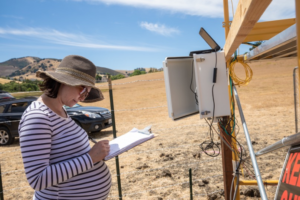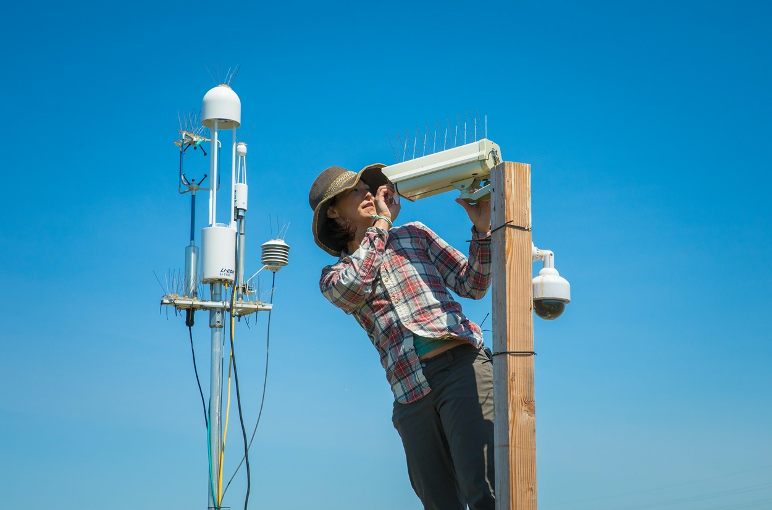Patty Oikawa is an assistant professor of Earth and Environmental Sciences at California State University East Bay, in the San Francisco Bay Area. She has been a member of AmeriFlux since 2013, and currently has field sites located in Eden Landing Ecological Reserve, a restoring salt marsh, and a rangeland in Concord at the Galindo Creek Field Station. Patty has previously worked in high temperature agroecosystems, degraded peatlands, rice paddies, and restored freshwater wetlands. Patty’s research combines soil microbial process modeling and field eddy covariance measurements. We interviewed her to learn how she has launched a career combining both modeling and flux observations.

Patty Oikawa is an assistant professor of Earth and Environmental Sciences at California State University East Bay, in the San Francisco Bay Area.
Please tell us briefly about yourself. How did you first become interested in ecosystem fluxes and learn about FLUXNET?
I have been measuring trace gases since I was 20, studying plant-plant communication in chaparral systems as an undergraduate at UC Santa Barbara. During my PhD, I was part of a Biosphere-Atmosphere NSF training program at the University of Michigan Biological Station, where I was first exposed to ecosystem flux measurements (i.e. the PROPHET tower). As a postdoc at UC Riverside, I had my first experience with managing an eddy covariance tower while studying carbon and nitrogen cycling in high temperature agroecosystems. Then I joined Dennis Baldocchi’s lab at UC Berkeley for my second postdoc and became immersed in ecosystem scale flux measurements, Ameriflux and FLUXNET, as well as using those data to inform models.
What are your most recent studies about? What’s the main take-home message and what is particularly exciting about the studies?
The majority of my research right now is focused on constraining carbon budgets in wetlands, specifically tidal marshes. Tidal marshes are extremely complex and dynamic ecosystems, with CO2 and CH4 exchange as well as lateral carbon exchange through tidal flow. My lab established an eddy covariance tower in a restored tidal marsh in San Francisco Bay (US-Edn) in 2018 and have been measuring CO2 and CH4 exchange for approximately 2 years now. Due to high salinity and a heterogeneous footprint, CH4 exchange is extremely low and variable, making ecosystem scale measurements difficult. Partitioning net ecosystem exchange of CO2 is also difficult due to low ecosystem respiration at the site, especially at nighttime when the surface is usually flooded. These complexities are creating fun and fascinating problems that we are addressing with lots of different approaches (e.g., chamber measurements, footprint partitioning, and measurements of dissolved carbon fluxes).
So far the tower is measuring uptake of ~400 g C m-2 yr-1 but a large proportion of the sequestered CO2 is likely being lost in dissolved form through tidal flow. Nevertheless, despite the high salinity at the site, the carbon uptake is high, raising questions about how restoration influences carbon uptake and how best to model these disturbed ecosystems.

The majority of Patty’s research is focused on constraining carbon budgets in wetlands, specifically tidal marshes.
Please tell us how FLUXNET and the regional networks helped you advance in your career.
Right now I am leading a methane working group with the CCRCN, the Coastal Carbon Research Coordination Network. We are using Ameriflux data to help parameterize models used to predict methane budgets in tidal wetlands. We are also coordinating with the Ameriflux team to work towards building standardized databases of CH4 chamber measurements to help inform ecosystem-scale measurements. We hope to use these data to develop and test a hierarchy of CH4 models and constrain national CH4 budgets in coastal wetlands.
How has your methane work evolved over the years? In what ways are you participating in AmeriFlux Year of Methane activities?
Since beginning my work in wetlands, methane has been a top priority. But in the last year, my involvement with larger scale methane measurements and modeling has really expanded. Beyond the CCRCN work, I am also a co-PI on a NASA CMS grant focused on collecting CH4 measurements from tidal marshes along 3 coasts of the US and experimenting with remote sensing products to improve CH4 budgets through the development of better salinity maps and forecasting tools. My colleague James Holmquist presented on these activities at the 2019 Ameriflux Meeting. I also wrote a post about the CCRCN work on the Ameriflux blog.
What resources or skills would you recommend that early career members of FLUXNET should acquire?

“Short courses such as these give you the opportunity to learn new skills from experts outside of your institution and make new friends while traveling the world.”
For the longest time I was strictly an experimentalist. My PhD involved fairly complicated measurements of methanol emissions from leaves in the field, which involved a lot of analytical chemistry in the lab. The datasets were small and simple to handle but as my research has expanded into other areas I have needed to acquire training in coding, statistics, modeling, etc. These are skills that I believe all early career scientists need. But I wouldn’t worry if your PhD doesn’t involve deep understanding in all of these areas, there is always time to gain experience during a postdoc!
I have also benefited from taking short courses such as the Flux Course offered in Boulder Colorado, Biosphere-Atmosphere themed short courses in Hyytiälä Finland, and the Data Assimilation Course offered in Trieste, Italy. Short courses such as these give you the opportunity to learn new skills from experts outside of your institution and make new friends while traveling the world. I’ll never forget the feeling of jumping into the icy fjord after baking in the sauna with a bunch of giggling friends at Hyytiälä Field Station.
How can early career members of FLUXNET, or the regional networks, benefit or learn from the different network activities?
Participating in FLUXNET or regional network activities is another way to network and push yourself to think more broadly about fluxes. It is easy to get engrossed in your field site(s) or region, but these activities force you to step back and digest these data at uncomfortably large scales (my mom always says “If you’re not uncomfortable, you’re not pushing yourself enough!”). The community needs more scientists who can bridge between scales and nimbly work with large datasets, expanding and contracting as necessary depending on the scientific question. I would advise away from solely focusing your skills at either the site or global scale. Ideally, we would all have experience with both.

